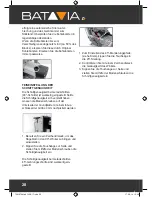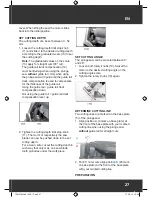
33
EN
1. When installing the miter limit stop on the
guide rail first set the desired angle and
slide the miter limit stop into the groove of
the guide rail.
2. Tighten the front clamping screw to fix the
angle setting.
3. Place the miter limit stop at the straight side
of the work piece.
4. Tighten the second clamping screw to fix
the miter limit stop tightly on the guide rail.
5. Slide the miter limit stop into the groove of
the guide rail and set the angle by means of
the notches from 0° to 45° when installing
the miter limit stop on the guide rail.
Note:
The pre-punched notches match the
curved angle scale.
6. Tighten the second clamping screw to fix
the miter limit stop tightly on the guide rail.
PARALLEL LIMIT STOP AND/OR TABLE
EXPANSION (OPTIONAL)
For cut-off widths up to 180 mm a parallel limit
stop can be used. The parallel limit stop can
also be used as table expansion.
1. Slide the parallel limit stop into the
respective guides at the front and rear of
the base plate.
2. Measure the desired distance and fix the
parallel limit stop with the clamping screws
(9).
SAW BLADES
Compatible saw blades are necessary for the
plunge saw to cut different materials fast and
clean.
Saw blades with few teeth (approx. 12 – 18
teeth) are suitable for longitudinal cuts.
For cross cuts saw blades with at least 32
teeth are suitable; better are saw blades with
48 teeth.
For cutting other materials such as aluminum
special saw blades are necessary.
CLEANING AND MAINTENANCE
Disconnect from mains power before carrying
out any maintenance work on the plunge saw!
All maintenance and repair work involving
opening the motor casing must be carried out
7061274 Ma # 1406-17.indd 33
17-06-14 13:29
















































